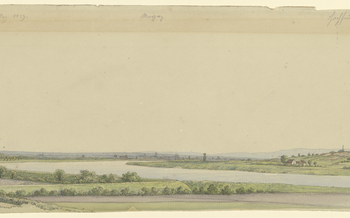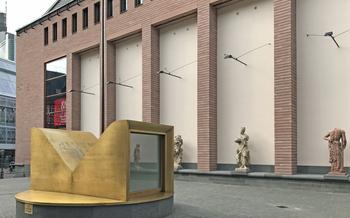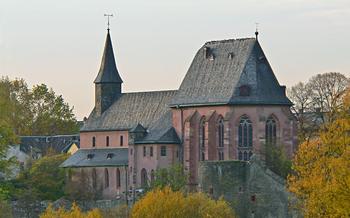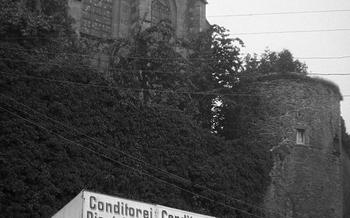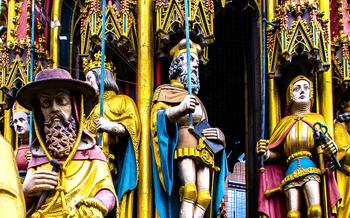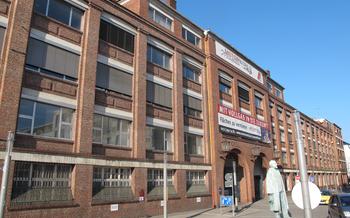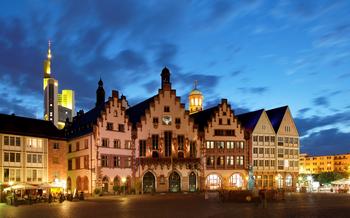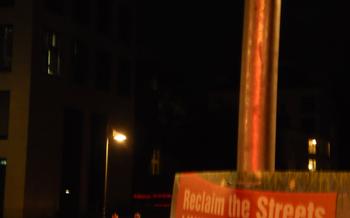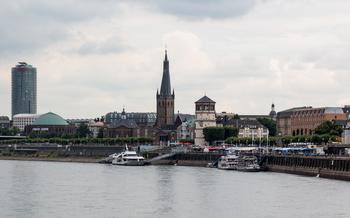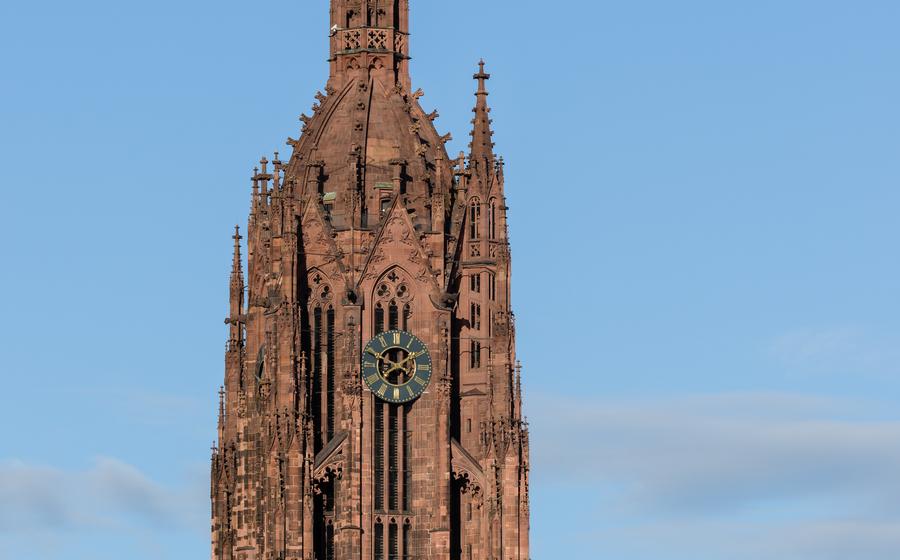
Kaiserdom St. Bartholomäus
- The Kaiserdom St. Bartholomäus: A Gothic Masterpiece
- History and Origins
- Architectural Highlights
- Imperial Elections
- Religious Significance
- Visiting the Kaiserdom
- Interior Exploration
- Crypts and Tombs
- Kaiserdom Museum: A Journey Through History
- Views from the Tower
- Surrounding Area
- Local Legends and Folklore
- Restoration and Preservation: A Labor of Love
- Insider Tip:
The Kaiserdom St. Bartholomäus: A Gothic Masterpiece
The Kaiserdom St. Bartholomäus, also known as the Frankfurt Cathedral, stands as a testament to the city's rich history and architectural prowess. This magnificent Gothic masterpiece, nestled in the heart of Frankfurt, has played a pivotal role in the city's religious, political, and cultural landscape for centuries.
As one of Germany's most significant cathedrals, the Kaiserdom boasts an awe-inspiring presence that draws visitors from far and wide. Its intricate stone carvings, soaring spires, and stained-glass windows epitomize the Gothic architectural style and showcase the extraordinary craftsmanship of medieval artisans.
Beyond its architectural splendor, the Kaiserdom holds immense historical significance. It served as the site of imperial elections and coronations for centuries, cementing its status as a symbol of imperial power and authority. The cathedral's walls bear witness to the pomp and pageantry of these grand ceremonies, forever etched in the annals of German history.
History and Origins
The Kaiserdom St. Bartholomäus has a rich and storied history, dating back to the 9th century. Its origins are closely intertwined with the rise of Frankfurt as a significant city and the Holy Roman Empire's imperial ambitions.
The founding of the cathedral is attributed to Emperor Charlemagne, who played a pivotal role in establishing Frankfurt as a royal residence and a center of ecclesiastical power. In 850 AD, Charlemagne commissioned the construction of a church on the site of an earlier Merovingian chapel, dedicated to Saint Bartholomew. This marked the beginning of the Kaiserdom's long and illustrious history.
Throughout the Middle Ages, the Kaiserdom served as a symbol of imperial authority and religious devotion. It underwent several expansions and renovations during this period, reflecting the growing wealth and influence of Frankfurt and the surrounding region. Despite numerous wars and fires that ravaged the city, the cathedral miraculously survived, standing as a testament to its enduring resilience and cultural significance.
Architectural Highlights
The Kaiserdom St. Bartholomäus is a testament to the Gothic architectural style that flourished in Europe during the Middle Ages. Its intricate design and soaring spires are a visual feast, showcasing the skill and artistry of the era's master builders.
Gothic Architecture and Its Influence: The cathedral's Gothic architecture is characterized by pointed arches, ribbed vaults, and flying buttresses, which create a sense of height and lightness. The intricate tracery of the windows and the ornate carvings on the facade add to the overall grandeur of the building. The influence of Gothic architecture can be seen in many other cathedrals and churches throughout Europe, making the Kaiserdom a prime example of this influential style.
Unique Features Like the Octagonal Tower: One of the most distinctive features of the Kaiserdom is its octagonal tower, which rises above the city skyline. The tower, which serves as a symbol of Frankfurt, offers breathtaking panoramic views of the city and the surrounding region. Its unique shape and intricate carvings make it a standout feature of the cathedral's exterior.
Interior Design and Ornamentation: The interior of the Kaiserdom is equally impressive, with its soaring nave, intricate carvings, and colorful stained glass windows. The high altar, with its intricate carvings and gold leaf, is a focal point of the cathedral. The choir stalls, with their elaborate carvings and inlaid woodwork, are another highlight of the interior design.
Comparison to Other Gothic Cathedrals: The Kaiserdom St. Bartholomäus ranks among the finest examples of Gothic architecture in Germany. Its grandeur and architectural features rival those of other notable Gothic cathedrals, such as the Cologne Cathedral and the Notre Dame Cathedral in Paris. Each of these cathedrals has its own unique characteristics, but the Kaiserdom stands out for its octagonal tower and its role in the history of imperial elections.
Imperial Elections
The Kaiserdom St. Bartholomäus holds a unique place in German history as the site of imperial elections for centuries. During the Holy Roman Empire, the cathedral served as the backdrop for the coronation of emperors, a tradition that began in the 14th century and continued until the empire's dissolution in 180
The coronation ceremonies were elaborate affairs, steeped in symbolism and religious significance. The emperor-elect would arrive in Frankfurt in a grand procession, accompanied by electors, dignitaries, and the imperial army. After a solemn Mass in the cathedral, the Archbishop of Mainz would place the imperial crown on the new sovereign's head, signifying their authority and legitimacy.
Notable among the emperors crowned in the Kaiserdom were Charles IV, who received the crown in 1349, and Maximilian I, crowned in 148These coronations not only cemented the cathedral's status as a symbol of imperial power but also underscored Frankfurt's importance as a political and cultural center of the Holy Roman Empire.
The tradition of imperial elections in the Kaiserdom came to an end with the collapse of the empire in the early 19th century. However, the cathedral's legacy as a stage for momentous historical events continues to draw visitors and pilgrims from around the world.
Religious Significance
The Kaiserdom St. Bartholomäus holds immense religious significance for the Catholic community in Frankfurt and beyond. It serves as a spiritual center, a place of worship, and a symbol of faith. The cathedral is dedicated to Saint Bartholomew, one of Jesus' twelve apostles, who is revered as the patron saint of the city. His relics are believed to be enshrined within the cathedral, further enhancing its religious importance.
Throughout history, the Kaiserdom has been a witness to countless religious ceremonies, rituals, and events. Mass is held regularly, attracting a congregation of devoted worshippers. Special services, such as baptisms, confirmations, and weddings, are also conducted within the cathedral's sacred walls. The grandeur and solemnity of the setting create a profound atmosphere for these significant life events.
Furthermore, the cathedral hosts various religious festivals and celebrations throughout the year. The most notable among these is the annual Bartholomäusfest, a week-long fair that takes place in August. During this festival, the city comes alive with processions, music, food, and revelry, honoring the patron saint and celebrating the community's faith.
Visiting the Kaiserdom
Practical Information for Tourists:
To fully appreciate the grandeur of the Kaiserdom St. Bartholomäus, it's essential to plan your visit wisely. The cathedral is open to the public daily, offering free admission for all. Guided tours are available for a deeper dive into its history and significance, typically led by knowledgeable guides who share fascinating insights. It's advisable to check the official website or contact the cathedral directly for specific timings and reservations. While there's no strict dress code, respectful attire is encouraged, considering the sacred nature of the site.
Interior Exploration
Venturing inside the Kaiserdom St. Bartholomäus reveals a breathtaking display of Gothic artistry and grandeur. The soaring nave, supported by intricate ribbed vaults, creates a sense of awe and reverence. Adorned with intricate carvings and sculptures, the choir stalls depict scenes from the life of Christ, inviting visitors to contemplate the sacred narratives. The high altar, adorned with gold leaf and shimmering mosaics, serves as a focal point for worship and devotion.
Stained glass windows bathe the interior in a kaleidoscope of colors, casting a mystical glow upon the venerable space. Each window tells a unique story from the Bible, narrating tales of faith, hope, and redemption. The intricate details and vibrant hues of the glasswork create an otherworldly atmosphere, transforming the cathedral into a sacred haven.
Among the many treasures housed within the Kaiserdom, the rood screen stands out as a remarkable masterpiece. Exquisitely carved from stone, this ornate barrier separates the nave from the chancel, symbolizing the transition from the secular to the sacred. Its intricate tracery and delicate sculptures showcase the exceptional craftsmanship of medieval artisans.
Whether you admire the intricate beauty of the altar, marvel at the radiant stained glass windows, or contemplate the profound symbolism of the rood screen, the interior of the Kaiserdom offers a feast for the eyes and a sanctuary for the soul.
Crypts and Tombs
Beneath the Kaiserdom St. Bartholomäus lies a hidden world of crypts and tombs, whispering tales of the past. These hallowed chambers hold the remains of notable figures who played a pivotal role in Frankfurt's history. Among them, Emperor Günther von Schwarzburg, who ruled the Holy Roman Empire in the 14th century, rests in an elaborate tomb adorned with intricate carvings depicting scenes from his life. Other notable burials include Archbishop Johann von Nassau, whose impressive effigy portrays him in full regalia, and the von Stalburg family, whose tombs line the walls of the crypt, each adorned with unique coats of arms and inscriptions.
The crypts and tombs of the Kaiserdom are a testament to the rich history and cultural heritage of Frankfurt. They offer a glimpse into the lives of those who shaped the city's destiny, providing a tangible connection to the past. While exploring these subterranean chambers, one cannot help but feel a sense of awe and reverence for the individuals who lie in eternal repose beneath the majestic cathedral.
Kaiserdom Museum: A Journey Through History
Within the sacred walls of the Kaiserdom, a hidden treasure awaits discovery. The Kaiserdom Museum, an on-site sanctuary of knowledge, invites visitors to delve into the rich tapestry of the cathedral's past. Through carefully curated artifacts, ancient documents, and interactive exhibits, the museum unravels the intricate story of the Kaiserdom's construction, its role in imperial coronations, and its enduring significance as a spiritual and cultural beacon.
Exhibits showcase the cathedral's architectural evolution, from its humble beginnings to its transformation into a Gothic masterpiece. Visitors can trace the hands of history through the centuries, witnessing the cathedral's resilience amidst wars and renovations. Rare documents, including medieval manuscripts and papal bulls, offer a glimpse into the lives of those who shaped the cathedral's destiny.
Interactive displays bring the past to life, allowing visitors to experience the grandeur of imperial coronations, hear the echoes of religious ceremonies, and marvel at the intricate details of the cathedral's artwork. Educational resources provide a deeper understanding of the symbolism and iconography that adorn the cathedral's every corner.
The Kaiserdom Museum is not merely a repository of artifacts; it is a living testament to the enduring power of faith, history, and art. It invites visitors to connect with the cathedral's spirit, to appreciate its enduring legacy, and to marvel at the enduring beauty that has captivated generations.
Views from the Tower
The octagonal tower of the Kaiserdom St. Bartholomäus stands as a testament to the architectural prowess of the Gothic era. Visitors can ascend the tower's winding staircase to reach the viewing platform, where panoramic vistas of Frankfurt unfold before their eyes. The climb offers a unique perspective of the city's skyline, with the Main River snaking through the urban landscape and the spires of other churches piercing the horizon.
From the tower's vantage point, visitors can appreciate the intricate details of the cathedral's exterior, including the flying buttresses and gargoyles that adorn its walls. The surrounding cityscape reveals a tapestry of historical landmarks, modern skyscrapers, and verdant parks, showcasing the harmonious blend of old and new that defines Frankfurt.
Safety measures are in place to ensure a secure and enjoyable experience for visitors. The staircase is well-lit and equipped with handrails, providing a safe passage to the viewing platform. Additionally, the platform is enclosed with sturdy barriers, allowing visitors to admire the views without compromising their safety.
While the ascent may require some effort, the breathtaking views from the tower are undoubtedly worth the climb. It offers a chance to immerse oneself in the history of Frankfurt and witness the city's vibrant transformation from a medieval town to a modern metropolis.
Surrounding Area
The Kaiserdom St. Bartholomäus stands as a majestic centerpiece within the vibrant Römerberg square, the heart of Frankfurt's Altstadt (Old Town). This historic district is a treasure trove of medieval architecture, with charming half-timbered houses lining the cobbled streets. Just a stone's throw away from the cathedral, visitors can marvel at the Römer, Frankfurt's historic town hall, with its iconic stepped gables and intricate Renaissance details.
A short stroll from the Kaiserdom leads to the Main River, where picturesque bridges offer stunning views of the city skyline. Take a leisurely walk along the riverbank, admiring the modern skyscrapers and historic buildings that harmoniously coexist in Frankfurt's cityscape. Cross the Eiserner Steg, an iconic pedestrian bridge adorned with thousands of love locks, and find yourself in the buzzing Sachsenhausen district.
Sachsenhausen, with its narrow streets and traditional Apfelwein pubs, offers a glimpse into Frankfurt's rich culinary scene. Indulge in a hearty meal at one of the many Apfelweinwirtschaften, where you can sample local delicacies like Frankfurter Rippchen (pork ribs) and Handkäs mit Musik (a pungent cheese dish).
For a panoramic view of the city, climb the Main Tower, Germany's tallest skyscraper. Located just a short distance from the Kaiserdom, the Main Tower offers breathtaking vistas that extend far beyond Frankfurt's urban sprawl, allowing you to appreciate the city's unique blend of history and modernity.
Local Legends and Folklore
The Kaiserdom St. Bartholomäus is steeped in a rich tapestry of myths, legends, and folklore that have been passed down through generations. One enduring tale speaks of a mysterious monk who is said to roam the cathedral's cloisters at night, his footsteps echoing through the silent halls. Legend has it that this monk is the spirit of a former abbot who was unjustly accused of heresy and condemned to wander the earth for eternity.
Another popular legend tells of a secret tunnel that is said to connect the cathedral to the nearby Römerberg square, the heart of Frankfurt's old town. According to the story, this tunnel was used by the city's magistrates to escape in times of danger. While the existence of this tunnel has never been proven, it continues to capture the imagination of locals and visitors alike.
These legends and stories add a touch of magic and mystery to the Kaiserdom, enhancing its allure as a place of both historical and cultural significance. They serve as a reminder that the cathedral is not just a building but a living, breathing entity that has witnessed centuries of human history and emotion.
Restoration and Preservation: A Labor of Love
Even with its resilience and architectural prowess, the Kaiserdom St. Bartholomäus is not immune to the effects of time and wear. The ongoing preservation efforts are a testament to the dedication of the local community and the importance placed on safeguarding this cultural treasure.
The passage of time and exposure to the elements have taken their toll, necessitating regular maintenance and renovations. Over the years, the cathedral has undergone several restoration projects to address structural issues, repair damaged elements, and maintain its original splendor.
One of the primary challenges lies in balancing the need for preservation with the desire to retain the cathedral's historical integrity. Restoration work is meticulously planned and executed to ensure that any changes or repairs are in keeping with the original design and materials.
The financial burden of maintaining such a vast and intricate structure is substantial. Donations from the faithful, along with support from the government and private organizations, play a crucial role in funding these restoration projects.
Through the collective efforts of skilled craftsmen, historians, and passionate individuals, the Kaiserdom St. Bartholomäus continues to stand as a testament to the enduring power of faith, architecture, and cultural heritage.
Insider Tip:
For an immersive and tranquil experience, consider visiting the Kaiserdom during weekdays or early mornings, when the crowds are usually smaller. This serene atmosphere allows you to fully appreciate the cathedral's grandeur and intricate details without distractions. Additionally, the Kaiserdom offers unique events and services throughout the year, such as special masses, concerts, and guided tours. These events provide an opportunity to delve deeper into the cathedral's history, architecture, and religious significance. Don't miss the chance to witness the Kaiserdom illuminated at night, casting an ethereal glow that transforms the surrounding area.
